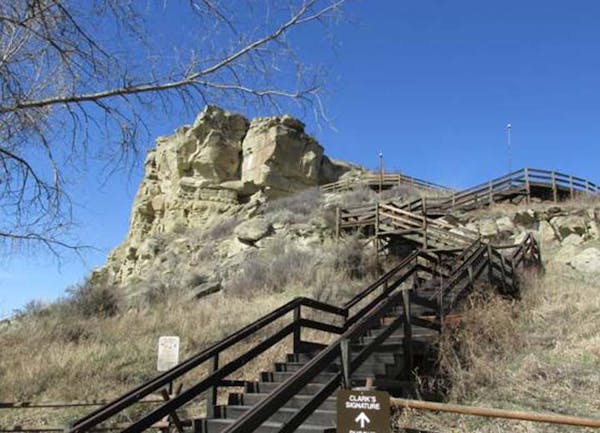The confessed vandal who carved a pair of names into a national monument says it was all just a misguided declaration of love.
Minnesotan Cole Randall told investigators that a cancer scare for his new wife led him to carve their names into Pompeys Pillar, a sandstone column that also bears inscriptions marking the passage of the Lewis and Clark expedition that explored the American West.
In his statement, which he also e-mailed to the Star Tribune and posted on its website, he called the act "definitely stupid and misguided."
He wrote that it all began when his honeymoon with Swedish bandmate Shpresa Lleshaj was cut short last month when she discovered "a suspicious lump on her breast.
"I was scared … terrified actually, worst-case scenarios raced through my mind," wrote Randall, 23. "When love and fear of loss team up: we sometimes lose our better judgment … If something were to happen to my wife, I could come back to this place years from now and see her and my names together."
Federal investigators with the Bureau of Land Management are slated to perform a "damage assessment" before deciding if felony charges will be filed against Randall or his wife stemming from the carvings in Pompeys Pillars National Monument. He carved their first names 207 years and three months after explorer William Clark tagged his moniker in 1806.
"The letter does indeed appear to be authentic," BLM spokeswoman Kristen Lenhardt said from Billings, noting the information in Randall's letter "is consistent" to the confession he gave investigators.
The case was never much of a mystery. During the government shutdown on Oct. 10, no caretakers were working at the sandstone monument 29 miles east of Billings. But an alarm notified Yellowstone County deputies that someone had stepped over a fence.
Randall and Lleshaj, who live in Plymouth, gave a deputy their names, but videotape later revealed he had carved their first names with a plus sign, a heart and the date. The act outraged locals.
In his letter, Randall noted that Clark and he were both following a tradition of American Indians and other earlier travelers who left their names.
"The major difference is the federal government purchased the pillar from private ownership in 1991 and put up signs everywhere prohibiting defacing the monument," said Jonathan Peart, executive director of the Friends of Pompeys Pillar nonprofit group.
Randall, who has roots in Park Rapids, Minn., and is part of a folk duo with his wife called Flora Cash, said he is "prepared to face the consequences" and described his act as foolish. He said his wife advised against the carving, "but I insisted."
He declined to talk about the case, saying he's still shaken up from hate mail. In his letter, he said: "I have learned a valuable lesson … I understand the gravity of my mistake," which he called a "declaration of love."
Peart, the leader of the nonprofit group aimed at preserving the monument, said: "It's a bit premature to offer forgiveness while we're still coming to terms with the damage to a historical site that Montanans love as part of the history of the Lewis and Clark Expedition."
But he thanked Minnesotans who have sent in donations to repair the damage.

Showdown over DEI programs threatens Anoka-Hennepin schools budget
House fire north of St. Cloud kills man, 76

Driver pulled from burning car on I-94 in St. Paul thanks good Samaritans for saving his life

